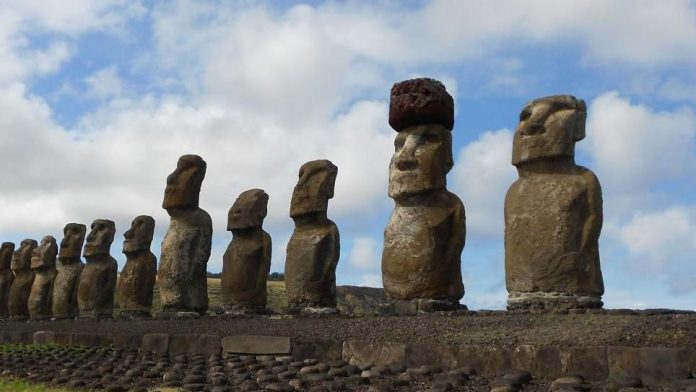Ancient inhabitants of Rapa Nui (Easter Island) may have used their mysterious giant stone heads to mark sources of fresh water.
Researchers have long been baffled by the giant statues across the island.
However, now they believe they could be simply marking water sources needed by the lost civilization to survive.
A new study found the lost civilization may have maintained a society of thousands by utilizing coastal groundwater discharge as their main source of ‘freshwater’.
A team of archaeologists including faculty at Binghamton University and State University at New York measured the salinity of coastal water around the island of Rapa Nui.
They found areas close to the shores had a salt concentration low enough for humans to safely drink.
The island’s famous statues have a high concentration near the coasts.
‘Now that we know more about the location of freshwater, however, the location of these monuments and other features makes tremendous sense: they are positioned where freshwater is immediately available,’ Binghamton University Professor of Anthropology Carl Lipo said.
Lipo said the group’s next project is to try to understand how closely the availability of freshwater in certain locations is linked to the methods and means of building the large statues on the island.
European accounts of first encounters with the island in the 18th century include passages where the natives appear to simply drink seawater.
Since the human body cannot process the high salt concentration of seawater, this supports the team’s groundwater discharge theory.
‘This information ultimately sheds light on the conditions that drove and enabled these communities to work together to achieve their feats of engineering,’ Lipo said.
‘By gaining knowledge about community scale behavior, we can gain insights into the general conditions necessary for group-level cooperation – whether in the past or in contemporary society.’
The process of coastal groundwater discharge makes it possible for humans to collect drinkable freshwater directly where it emerges at the coast of the island.
By measuring the percentage of salt in the coastal waters, and finding it safe for human consumption, and by eliminating other options as primary sources of drinking water, the researchers concluded that groundwater discharge was a critical factor in the sustenance of the large population the island is thought to have harbored.
‘The porous volcanic soils quickly absorb rain, resulting in a lack of streams and rivers,’ Lipo said.
‘Fortunately, water beneath the ground flows downhill and ultimately exits the ground directly at the point at which the porous subterranean rock meets the ocean.
‘When tides are low, this results in the flow of freshwater directly into the sea.








